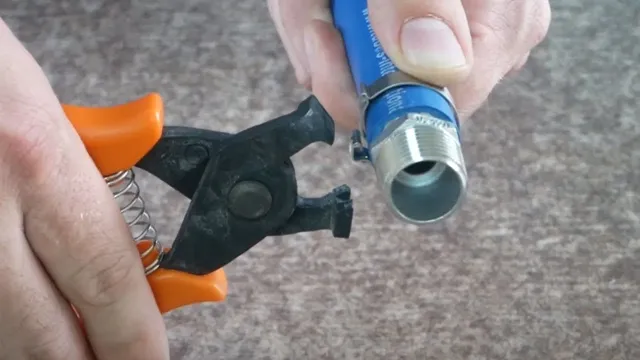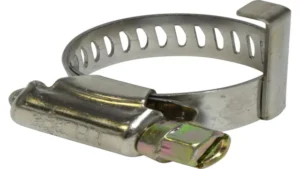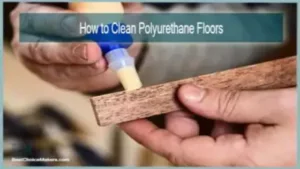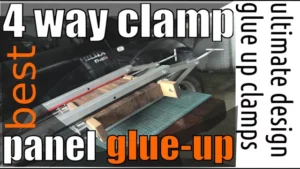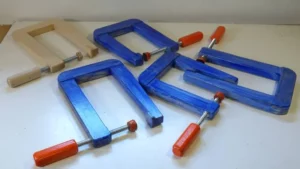Hose clamps are tiny, often-overlooked pieces of hardware that play a significant role in many devices in our everyday life. They are often invisible, serving as connections between different parts and materials, but their importance cannot be denied. Have you ever wondered how hose clamps work and what purpose they serve in various mechanisms? Well, look no further as we dive into the details of hose clamps’ mechanics and functionality.
In this blog, we will explore the critical aspects of hose clamps and their significance in creating and maintaining seal integrity. So, sit tight and get ready to learn all you need to know about hose clamps and their role in ensuring your machines and devices function correctly.
Introduction
Have you ever wondered how hose clamps work? Hose clamps are a small but essential part of any plumbing or fluid transfer system. They work by applying pressure to the hose, preventing it from slipping off the fitting or leaking. The adjustable screw on the clamp tightens or loosens the band, allowing the clamp to fit snugly on the hose.
As the screw is tightened, it compresses the hose against the fitting, creating a tight seal. Hose clamps come in many shapes and sizes, including worm drive, spring, and wire clamps, ensuring there is a clamp solution for all types of hoses and fittings. So, the next time you work with hoses, remember the important role hose clamps play in keeping everything securely in place.
Explanation of Hose Clamps
Hose clamps are essential tools used in various industries, including automotive, marine, and plumbing. They are designed to securely attach hoses onto fittings, preventing leaks and ensuring smooth fluid flow. Hose clamps come in different types and sizes, from the traditional worm-drive clamps to the more modern constant tension clamps.
When selecting a hose clamp, it’s important to consider the type of hose material, the size, and the application. One of the benefits of using hose clamps is their versatility, as they can be easily adjusted, removed, and re-used if needed. Additionally, they are relatively inexpensive and require minimal maintenance.
So, whether you’re a DIY enthusiast or a professional mechanic, a hose clamp is a must-have tool in your toolkit.
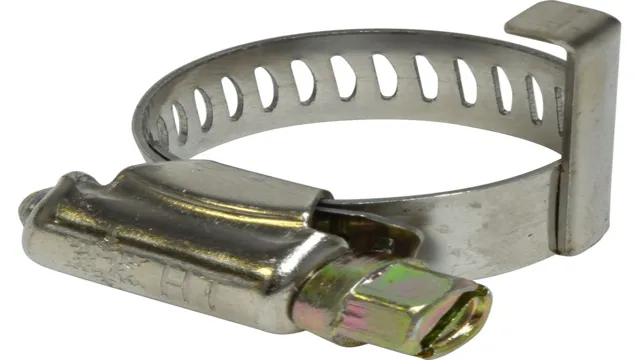
Types of Hose Clamps
Hose clamps are an essential part of any plumbing system, used to secure hoses and pipes tightly in order to prevent leaks or spills. There are many different types of hose clamps available on the market, each designed for specific purposes and applications. Whether you need a clamp for high-pressure or low-pressure systems, there’s a hose clamp out there that will meet your needs.
One of the most commonly used types of hose clamps is the worm gear clamp, which features a screw that tightens and loosens the clamp. Other types include ear clamps, which use a special tool to crimp the clamp onto the hose, and T-bolt clamps, which are used for more heavy-duty applications. No matter what type of hose clamp you need, make sure to choose one that is the right size and material for the job, in order to ensure a secure and leak-free connection.
Function of Hose Clamps
“How do hose clamps work?” is a common question asked by people who work with hoses. Hose clamps serve a critical function in keeping hoses attached to fittings, preventing any leakages that may lead to costly damages and dangerous accidents. These clamps work by applying pressure to the hose, which compresses it against the fitting, creating a tight seal that prevents any liquid or gas from escaping.
The clamps are usually made from metal and use a screw-type mechanism that tightens or loosens the clamp as needed. Different types of hose clamps are available, each with its unique features and applications, including spring clamps, worm gear clamps, and t-bolt clamps. It is essential to choose the right type of clamp for your specific application, ensuring that the hose stays securely in place.
Overall, hose clamps are essential components that play a crucial role in the safe and efficient operation of hoses in various industries.
Connecting and Sealing
Hose clamps serve a crucial function in connecting and sealing hoses. They are used to secure a hose onto a fitting, creating a tight seal that prevents leaks and ensures optimum flow of fluids. Hose clamps come in various sizes and styles, including worm gear clamps, spring clamps, and constant tension clamps.
Each type of clamp has its own unique features and benefits, making them suitable for different applications and industries. While hose clamps may seem like small components, they play a significant role in ensuring the efficiency and reliability of hoses in various systems, including automotive, industrial, and household. So, whether you’re working on a DIY project or dealing with a complicated system, choosing the right hose clamp is essential for achieving a tight seal and preventing downtime due to leaks or malfunctions.
Adjusting
If you’re dealing with leaks or loose connections in your hose system, hose clamps are a crucial tool to have. These clamps work by tightly securing hoses onto fittings, preventing them from slipping or leaking. Hose clamps come in various types, sizes, and materials to serve different purposes.
Some of the most common types include worm gear clamps, t-bolt clamps, and spring clamps. The adjustable nature of these clamps makes them a convenient solution, allowing you to tighten or loosen them as needed to ensure a proper fit. Whether you’re working on a car, a plumbing system, or any other application that involves hoses, hose clamps are a useful and essential tool to have on hand.
So, the next time you’re dealing with a leaky hose or a loose connection, consider using a hose clamp to easily solve the problem.
Preventing Hose Movement
Hose clamps are essential in preventing hose movement and ensuring that hoses remain securely attached to their fittings. These clamps are specifically designed to apply pressure on the hose, which then compresses the fitting, thereby preventing any leakage or movement. They are commonly used in automotive and manufacturing industries, as they play an integral role in the function of various systems.
Without hose clamps, hoses could easily slip out of their fittings, causing damage to the system and even possible injury to workers. Investing in high-quality hose clamps is necessary to ensure optimal performance and safety. Whether you’re in the manufacturing industry or simply performing DIY repairs on your car, be sure to use hose clamps to prevent any mishaps.
Installation of Hose Clamps
Hose clamps are essential when fitting a hose onto a pipe or valve. They secure the hose in place, ensuring a tight seal and prevent any leakage. The way they work is simple; they consist of a band of metal that encircles the hose and a screw mechanism that tightens it.
The band is made of stainless steel or another strong metal, which makes it durable and resistant to corrosion. The screw mechanism lets you adjust the tightness of the clamp to ensure a secure fit without damaging the hose. It is essential to position the clamp correctly and tighten it sufficiently to avoid any leaks.
Hose clamps come in various sizes and shapes to fit different types of hoses and pipes. The right-sized clamp should be used to ensure a tight and secure fit without over-tightening and causing damage. How do hose clamps work? Well, they keep hoses in place, allowing fluids and gases to flow efficiently.
With hose clamps, you can be sure your system is free from leaks and functioning correctly.
Step-by-Step Guide
Installing hose clamps may seem like a daunting task, especially if you are not familiar with industrial equipment. However, a few simple steps can make this task easy and hassle-free. Firstly, gather all the necessary tools you need, including screwdrivers, pliers, and a hose clamp that fits your hose size.
Next, locate the area where the clamp needs to be installed and position it in the correct position. Then, tighten the screw or bolt of the clamp using a screwdriver or pliers until it is secure, but not too tight. Lastly, check to see if everything is properly aligned, and ensure that there are no leaks or looseness in the clamp.
By following these simple steps, you can easily install a hose clamp without any issues.
Tips and Tricks
Installing hose clamps may seem like a daunting task, but with the right techniques, it can be done easily and efficiently. First and foremost, choose the appropriate size of the hose clamp for your hose. It is essential to make sure that the clamp fits snugly around the hose to ensure no leakage.
Once you have the right size, place the clamp on the hose and tighten it manually as much as possible. Next, use a torque wrench to secure the clamp even further. It is crucial to not over-tighten the clamp as it can damage your hose or fitting.
The perfect tightness ensures the clamp will stay in place without slipping or leaking. One helpful tip is to rotate the clamp when tightening to distribute the pressure evenly. With these easy-to-follow tips, installing hose clamps can be a breeze.
Conclusion and Maintenance
Hose clamps are like the superheroes of the plumbing world – they come in to save the day when regular connections just can’t cut it. With their adjustable design and powerful grip, hose clamps ensure that hoses stay put and leaks stay out. It’s like having your very own caped crusader guarding your pipes and preventing water disasters.
So next time you’re tightening up a hose clamp, remember that you’re not just fixing a leak – you’re unleashing the power of plumbing justice!”
FAQs
What are hose clamps used for?
Hose clamps are used for securing hoses onto fittings and preventing leaks.
Can hose clamps be reused?
Yes, hose clamps can be reused as long as they are not damaged or weakened.
What types of hose clamps are available?
There are several types of hose clamps, including worm gear clamps, spring clamps, braided hose clamps, and constant tension clamps.
How do worm gear clamps work?
Worm gear clamps work by tightening a screw, which causes the clamp to compress and secure the hose onto the fitting.
What materials are hose clamps made of?
Hose clamps can be made from various materials, including stainless steel, aluminum, and plastic.
How do you choose the right sized hose clamp?
The right size hose clamp should fit snugly around the hose and fitting, but not be too tight or too loose.
Can hose clamps be used for high-pressure applications?
Yes, hose clamps can be used for high-pressure applications as long as they are designed for the specific pressure rating and material compatibility.
